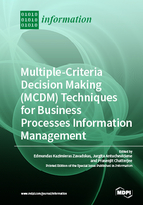Multiple-Criteria Decision-Making (MCDM) Techniques for Business Processes Information Management
A special issue of Information (ISSN 2078-2489). This special issue belongs to the section "Information Applications".
Deadline for manuscript submissions: closed (31 October 2018) | Viewed by 74036
Special Issue Editors
Interests: operations research; optimization and decision analysis; multicriteria decision making; multiattribute decision making (MADM); decision support systems; civil engineering; energy; sustainable development; fuzzy sets theory; fuzzy multicriteria decision making; sustainability; management; game theory and economical computing knowledge management
Special Issues, Collections and Topics in MDPI journals
Interests: multi-criteria decision-making (MCDM); multiattribute decision making (MADM); operations research; decision support systems; multiple-criteria optimization in construction technology and management; decision making under uncertainty; fuzzy sets theory; civil engineering; sustainable development; sustainable construction; investments; knowledge management
Special Issues, Collections and Topics in MDPI journals
Interests: multi-criteria optimization; multi-criteria decision-making; operations research; fuzzy optimization
Special Issues, Collections and Topics in MDPI journals
Special Issue Information
Dear Colleagues,
Information management is a common paradigm in modern decision-making. Today’s real-world problems involve multiple data sets, some precise or objective and some uncertain or subjective. A wide range of statistical and non-statistical decision-making techniques have been proposed in literature to model complex business processes. Statistical methods (i.e., probability theory) are useful in modeling processes with incomplete or inaccurate data, while non-statistical methods (i.e., fuzzy set theory, rough set theory, possibility theory, or fuzzy neural networks) are useful for modeling complex systems with imprecise, ambiguous or vague data. Multiple-criteria decision-making methods and hybrid models are quickly emerging as alternative methods for information modeling. Therefore, we invite authors to submit original research articles that propose crisp or uncertain multiple-criteria decision-making models and techniques to rationalize the complex process of business information management in various today’s real-world problems.
Prof. Edmundas Kazimieras Zavadskas
Prof. Jurgita Antuchevičienė
Dr. Prasenjit Chatterjee
Guest Editors
Manuscript Submission Information
Manuscripts should be submitted online at www.mdpi.com by registering and logging in to this website. Once you are registered, click here to go to the submission form. Manuscripts can be submitted until the deadline. All submissions that pass pre-check are peer-reviewed. Accepted papers will be published continuously in the journal (as soon as accepted) and will be listed together on the special issue website. Research articles, review articles as well as short communications are invited. For planned papers, a title and short abstract (about 100 words) can be sent to the Editorial Office for announcement on this website.
Submitted manuscripts should not have been published previously, nor be under consideration for publication elsewhere (except conference proceedings papers). All manuscripts are thoroughly refereed through a single-blind peer-review process. A guide for authors and other relevant information for submission of manuscripts is available on the Instructions for Authors page. Information is an international peer-reviewed open access monthly journal published by MDPI.
Please visit the Instructions for Authors page before submitting a manuscript. The Article Processing Charge (APC) for publication in this open access journal is 1600 CHF (Swiss Francs). Submitted papers should be well formatted and use good English. Authors may use MDPI's English editing service prior to publication or during author revisions.
Keywords
- Multiple-criteria decision-making (MCDM)
- Interval-valued fuzzy sets
- Intuitionistic fuzzy sets
- Neutrosophic sets
- Grey systems
- Rough number
- Hybrid multiple-criteria decision-making methods
- Data mining tools
- Data Envelopment Analysis
- Intelligent decision support systems
- Information technologies in decision-making
- Project portfolio selection
- Strategic partner evaluation and selection
- Ranking companies based on financial performance
- Contracting
- Procurement
- Site selection
- Resource allocation
- Supply chain management
- Production management
- Quality management
- Risk management
- Life-cycle analysis
- Negotiations
- Conflict resolution, etc.








